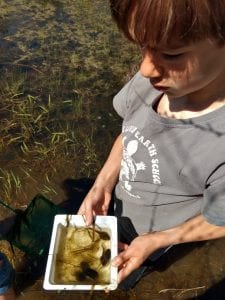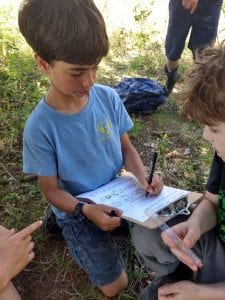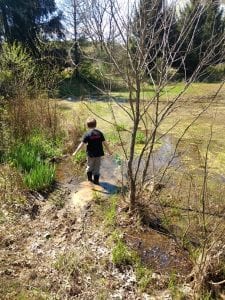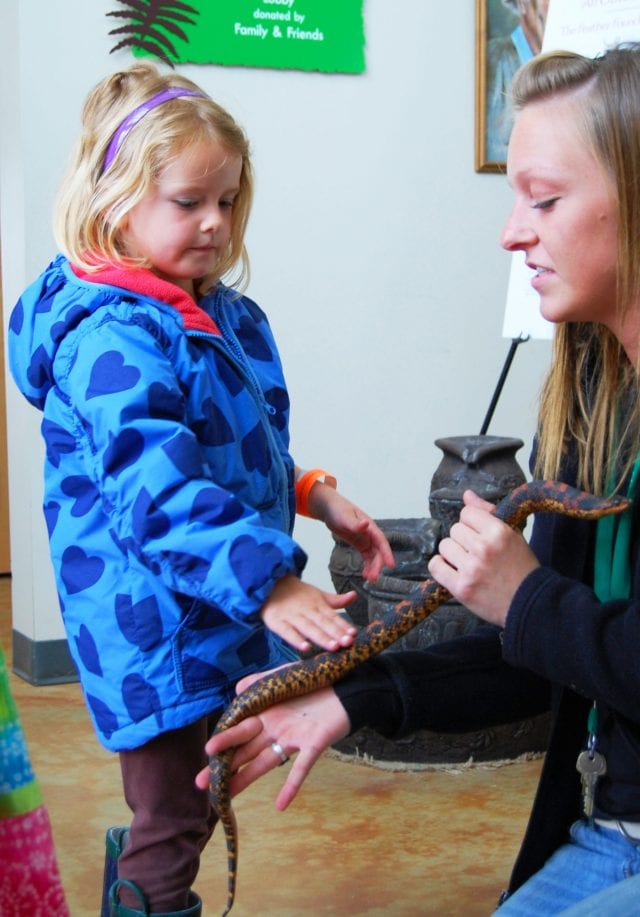4/23/2019
Happy Earth Day! Earth Day was on Monday but we celebrated it today with some citizen science at an Irvine pond. Before heading out on our long hike, we glued maps of Irvine in our journals so we could start keeping track of cool nature finds and places we’ve been. We also reviewed what our land artist, Richard Shilling because we will be creating an art installation inspired by him next week.
What is Earth Day and why are we celebrating it? We like to celebrate Earth Day every day here at Irvine by being outside, learning about nature, teaching other people about plants and animals and keeping nature clean and healthy for everyone. For our Earth Day we are going to take on the role of citizen scientist. A citizen scientist is someone who can participate in scientific research and report it themselves, for example, bird-a-thons where people count as many bird species as they can and this information can be imported into e-bird or BioBlitz where people work as a large group trying to find as many animal and plant species as possible in a national park. You can even use an app called iNaturalist to record your BioBlitz data! There are a lot of fun ways to participate, here are a few:
BioBlitz:
https://www.nationalgeographic.org/projects/bioblitz/
Backyard Bird Count:
Volunteering in Maryland for Beach Cleanups and more:
https://mdcoastalbays.org/volunteer
One of the ways we are going to participate in our own version of citizen science is to collect data on the health of a pond here at Irvine. We are going to use biotic data (living organisms) to help determine the health of the pond and do a chemical test to find out the chemical properties of the pond (abiotic data). We will then determine whether our pond is healthy, somewhat healthy, or not as healthy, based on our data for that day.
We hiked to the pond at the back of the Sunflower Meadow and split into two groups. Each group would get to do both activities. Before we started our data collection we first discussed the Leave No Trace principles and why they matter on Earth Day. Practicing the Leave No Trace principles is a great way to become a steward of the environment, someone that helps to take care of nature and educate others on how to live with less impact on the environment. Here are the 7 principles of Leave No Trace. You can read more about them here: https://lnt.org/why/7-principles/
- Plan Ahead and Prepare
- Travel and Camp on Durable Surfaces
- Dispose of Waste Properly
- Leave What You Find
- Minimize Campfire Impacts
- Respect Wildlife
- Be Considerate of Other Visitors
After reviewing each principle and thinking of ways we can enact each individually, we started our data gathering. Each group did a water test with a water test kit from LaMotte, it can be bought on Acorn Naturalist. Before doing our chemical tests we recorded the weather, date and water temperate. We then looked at the pond and estimated the % of algae cover. Why do we care about this? Well, algae can form large mats that block sunlight from reaching plants under the water. These water plants are critical habitat for young fish, amphibians, insects and provide food for animals like waterfowel. We decided that the % of algae cover was around 25-35%. Our water temperatures came out around 75 – 80 degrees F. The chemical components we were testing for were Dissolved Oxygen, Nitrate, Phosphate and pH.
Dissolved Oxygen is the amount of oxygen that is dissolved in the water. This is very important for fish, fish eggs, amphibians and insects that live in the water. Also, warmer water generally has less dissolved oxygen. Our readings were decent but changed based on where the water sample was taken. Closer to the edge of the water it was only 4ppm while in deeper water it was 10ppm (parts per million). The higher the number the better. Fish need around 5ppm, while fish like salmon need more than 10ppm to be able to lay and hatch eggs. Dissolved Oxygen looks good!
Nitrates are usually found in large amounts in water from excess fertilizer and sewage. Generally you don’t want nitrates too high because it will promote algae growth in large amounts. The algae then dies feeding bacteria, which need oxygen to survive, thus depleting the water of oxygen. Our nitrates were found to be at 5ppm, a good sign for sure!
Phosphates enter the water naturally from weathering on rocks but can also be introduced from sources like soaps that get washed into our water bodies. Our phosphates were low, only 1ppm!
Lastly, pH. pH is essentially the measure of hydrogen ions in the water and determines whether water will be acidic (like vinegar) or basic (like baking soda). For a freshwater pond the water should be between 6.5 and 7.5. Oddly, our pH was rather low, a 6. This might explain why we didn’t find as many insects or fish in our water. A pH of 6 means the water is more acidic, this can make it hard for animals like snails to build their calcium shells, for example. But why is the pH so low? It could be because the pond is vernal, meaning seasonal, and is heavily influenced by rainwater, which is generally more acidic (lower pH).
Overall, based on the chemical test the water is on the healthier side, good news! What about the macroinvertebrates? What lives in the water can also tell you a lot about the health of a water body. We used nets to do our sampling. We caught dragonfly and damselfly nymphs, both invertebrates that can live in somewhat healthy water (meaning the water doesn’t need to be extremely clean). We also found water beetles. The insect finds weren’t spectacular but we did find a lot of tadpoles of various sizes, adult frogs and an empty salamander egg case. These are good signs of a healthier body of water! Amphibians, especially salamanders are an indicator species, meaning, their presence or lack there of, is a sign of either a healthy body of water or a declining body of water. So finding amphibians is always a positive sign.
With the day winding down we emptied our boots of pond water and hiked back to Irvine. Our junior naturalist for today was Lev and he shared his homemade cordage for a bow he is making in a class. The cordage is made out of an artificial sinew. Thank you for sharing!







